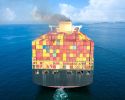Use of low-sulphur residual marine fuel oils not enough to reduce particle emissions from shipping

Reduced sulphur content in marine fuel oils will not be the only solution for reducing particle emissions from shipping. However, LNG can help reduce particle emissions. That are some of the findings from Maria Zetterdahl, Chalmers Department of Shipping and Marine Technology, in her doctoral thesis, Particle Emissions from Ships - Measurements on Exhausts from Different Fuels.
Since 1st of January 2015, ships operating in sulphur emission control areas, SECAs, have to use marine fuels with a sulphur content less than 0,1 %m/m. This requires ship owners to make a fuel shift and use low-sulphur marine fuel oils, use alternative fuels such as LNG (liquefied natural gas) or use scrubbers on-board their ships, to meet the requirements.
In her thesis Maria Zetterdahl focus on the first two methods and how fuel sulphur content and other fuel characteristics affect the particle emissions.
Impact on environment and health
There is a clear connection between particle emissions and impact on human health and environment, and that's why Maria became interested in particle emissions. Modelling studies have estimated that particle emissions from ships may be responsible for approximately 60 000 premature deaths from lung cancer and cardiopulmonary diseases annually on a global level. Furthermore, depending on the optical properties of the particles they can have either a heating or cooling effect on the atmosphere. However, there are no international regulations that directly regulate particle emissions from shipping.
When SECA was introduced, the main reason was to reduce the amount of sulphur oxides from ship operations, but there were also assumptions that particle emissions would be reduced by lower sulphur content in marine fuel oils. But Maria Zetterdahls' research shows that the assumptions haven’t really met the expectations.
The results presented in this thesis indicate that the particle emissions in SECAs are dominated by nanoparticles, independent of the fuel type used. A fuel shift from a heavy fuel oil, HFO, to a low-sulphur residual marine fuel oil (also called hybrid fuels) has no or little effect on the PN (particle number) emissions and the emissions are dominated by even smaller particles. However, the PM (particle mass) emissions were reduced.
However, use of LNG results in considerably reduced particle emissions compared to traditional marine fuel oils. In her thesis, Maria Zetterdahl writes:
A step in the right direction
The FSC (fuel sulphur content) regulation is a step in the right direction towards reduced particle emissions, if alternative fuels, such as LNG, or marine fuels, more similar to distillates, are used. Furthermore, the positive effects on human health from implementation of the FSC regulation may not be as large as expected if not other fuel characteristics are considered as well.
Marie Zetterdahl says that her thesis is a part of the initial work on particle emissions from ship operations and more research need to be done. One interesting subject is more measurements of emissions generated by the combustion of various hybrid fuels and other marine fuels. Another subject is the investigation of emissions from alternative fuels such as methanol. Also tests of different diesel particulate filters with different marine fuels is a very interesting field of future studies that could provide information about whether the use of diesel particulate filters is a potential solution in the marine transportation sector.
-
 NextWave – en podd som ska locka unga
NextWave – en podd som ska locka unga -
 Ny studie: Eldrivna pendelbåtar kan effektivisera Stockholms kollektivtrafik
Ny studie: Eldrivna pendelbåtar kan effektivisera Stockholms kollektivtrafik -
 Sjöfartens utsläpp ökar
Sjöfartens utsläpp ökar -
 Sociala relationer påverkar val av bränsle
Sociala relationer påverkar val av bränsle -
 Sjöfartens omställning kräver ”mjukare” påtryckningar
Sjöfartens omställning kräver ”mjukare” påtryckningar -
 Hon hade avtalad tid med Kapten ynkrygg
Hon hade avtalad tid med Kapten ynkrygg -
 Lighthouse omvärldsanalys 2025 – osäkerhet och tullar präglar sjöfarten
Lighthouse omvärldsanalys 2025 – osäkerhet och tullar präglar sjöfarten -
 Se seminariet Shipping in the Marine Environment
Se seminariet Shipping in the Marine Environment -
 Vad betyder egentligen de 90 procenten?
Vad betyder egentligen de 90 procenten? -
 Hålla där...
Hålla där...

